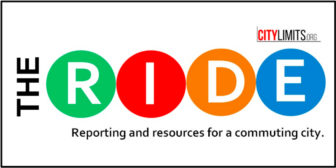
William Alatriste/Council
Speaker Corey Johnson seen in January riding the 7 train to Jackson Heights.
City Council Speaker Corey Johnson delivered his first State of the City address Tuesday in which he outlined an ambitious and wide-ranging plan to overhaul New York’s subways, buses and streets—including a proposal to shift control of the transit system to city government, with the mayor at its helm.
The speech—delivered before a crowd at Queens’ LaGuardia Community College, where Johnson was accompanied on stage by a prop subway station entrance and introduced by his mother—focused exclusively on transit, which the speaker called the “one issue that is threatening the future of our city.” It comes exactly a week after Gov. Andrew Cuomo and Mayor Bill de Blasio released their own 10-point plan to reorganize and shore up new funding for the beleaguered MTA.
“If people can’t move around, New York City can’t function,” Johnson said, after outlining a number of the MTA’s biggest woes, from sluggish subway and bus service to the agency’s skyhigh capital construction costs. He repeatedly emphasized his goal of breaking “car culture” in favor of policy that benefits pedestrians, cyclists and public transit users.
“We have to do something. The future of our city is at stake,” he said. “I see it, you see it, but no one is doing anything about it.”
Here are few key takeaways from Johnson’s speech and his accompanying 104-page “Let’s Go” transit proposal:
• Municipal control of NYC Transit: The focal point of Johnson’s announcement is to create a new mass transit system that would be run by the city government, replacing New York City Transit and the other MTA subsidiaries that currently operate the city’s transportation network. Johnson’s proposed entity, which he dubbed Big Apple Transit or BAT, would encompass the subways, buses, the Staten Island Railroad and the city’s bridges and tunnels. “Right now, we don’t control our fares, we don’t control the capital plan, we don’t control what gets built, we don’t even control our bus routes,” Johnson said. “We must take control of our destiny.” The mayor would ultimately be in charge of BAT, which would also be overseen by a board whose members would be required to live in the city and be regular public transit users, according to the plan. “It will never be in the best interests of any governor to put the needs of New York City above the rest of the state,” Johnson added.
• A master plan for city streets: Johnson says he plans to introduce legislation that would require the Department of Transportation to issue a “a comprehensive master plan for City streets” every five years, one that would set benchmarks for bus, bike, ferry and pedestrian infrastructure—including recommendations to install a minimum of 30 miles of new bus lanes and 50 miles of protected bike lanes each year. The plan also emphasizes the need for more shared streets, public plazas and pedestrian-friendly spaces. “Giving our streets back to people is good for business, it’s good for the environment and it’s good for all New Yorkers,” Johnson said.
• “Reimagining” the BQE: While the DOT is planning to reconstruct a 1.5 mile-stretch of the Brooklyn-Queens Expressway, Johnson argues that simply rebuilding the highway shouldn’t be the only option on the table. His plan calls for the city to engage with the public to consider other possibilities for the dilapidated roadway, pointing to places like Portland, Ore., which replaced one of its freeways with a public park.
“We have been living in Robert Moses’ New York for almost a century, and it is time to move on,” Johnson said, referencing the car-loving urban planner responsible for many of the city’s major roadways. “We need to take a fresh look at the BQE problem. We shouldn’t assume that the best way forward is the old, car-centric way.”
You can read Johnson’s full transit plan here.
Get the best of City Limits news in your inbox.
Select any of our free weekly newsletters and stay informed on the latest policy-focused, independent news.










2 thoughts on “Speaker Wants Mayor in Charge of Transit, 50 Miles of New Bike Lanes Each Year”
No. Imagine the same city that runs NYCHA running the buses and subways.
Pingback: New Exhibition Tracks the Centuries-Old Urban Debate Over Bicycles - Aah